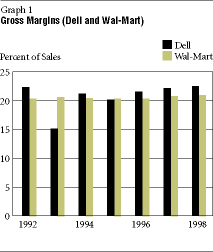Let's begin with a story of a time when large American industries had, generally speaking, become focused on expansion for its own sake and had lost touch with lessons learned from their earlier success. Large corporations were stagnating, and the conventional response was to get larger and—by sheer force of will—drive the economy onward. This, of course, was an exercise in futility and many companies paid the price for such mismanagement.
And then something "new" happened. Large corporations discovered that they had a pressing need to regain control over their inventories. How best to do so? The revolutionary, yet simple, answer was to take most of the day-to-day decisionmaking out of the hands of top executives and give the responsibility and the incentive to those who were really in tune with the demand for products and services.
"It is my belief that 90 percent of all questions arising will be settled without reference to the Executive Committee and that the time of the Executive Committee members may be fully employed to study general routine and lay down general policies for the Corporation, leaving the burden of management and the carrying out of instructions to the Line, Staff and Financial Divisions."
A 1990s fix for a corporate America grown sluggish from 1980s mergers and acquisitions and from tepid productivity growth? No, this was the response of Pierre du Pont and his management team—headed by Alfred P. Sloan Jr.—when du Pont took over a flagging General Motors after World War I. But these lessons-and others from history-provide a useful springboard for thinking about the changes occurring in today's economy.
We have recently entered a period of incredible prosperity—real gross domestic product growth of more than 4 percent from 1996 through 1999, and productivity growth over the same period of more than 2.5 percent—levels not seen for more than a quarter century. This is the type of growth that so surprises economists and other analysts that they think something funny must be going on, or something "new," because surely we can't have growth at such high levels for such a long time without the attendant inflation and other problems associated with an overheating economy. And they're right—something is going on, but it's not something that we can't understand or something that should necessarily concern policymakers. Quite the contrary: As we shall see, the growth that the U.S. economy is experiencing is less an aberration from previous rates and more a harbinger of potential growth.
There are three questions to explore when determining the nature of the current economy. First, what can we learn from the performance of America's best-run companies about the sources of recent productivity growth and its future? Second, is there something really new about the so-called new economy, or could these productivity increases have happened before the advent of new technologies, especially the Internet? And finally, are there constraints that will prevent us from having continued high economic growth?
Just as studying Sloan's managerial techniques at General Motors can provide insight into revolutionary changes wrought in the American industrial past, so can an analysis of America's best-run companies provide us with a laboratory for the current and future path of the economy.
Old world, new economy
We will start our investigation of recent economic growth by looking at two seemingly unrelated firms—Dell, the computer manufacturer, and Wal-Mart, the large retailer. Both of these firms are run very well, and despite how different their industries appear, if we just look at the gross margins for the two firms—that is, the fraction of their sales that they have remaining after paying for the costs of goods that they bought or produced—you would think that the two firms were in the same industry. If we take a look at Graph 1 we see that between 1994 and 1998, the gross margins for Dell and Wal-Mart were roughly the same, but this obviously only tells part of the story.
If we look further at the makeup of these two companies we can see a huge difference in the share of sales, general and administrative expenses as a fraction of total sales.
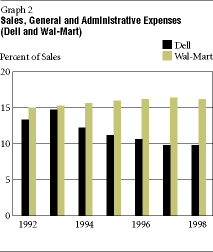 From 1993 to 1998, Wal-Mart's sales, general and administrative
expenses stayed roughly the same or rose slightly. Dell, on the other
hand, relentlessly cut these expenses as it moved certain tasks, including
sales, to the Internet. Because Dell was able to reduce its expenses so
drastically meant that its pretax operating margin grew much more rapidly
than Wal-Mart's during this time. From 1994 until 1998, Wal-Mart's pretax
operating margin (profits before taxes, divided by total sales) was roughly
flat at around 3.5 percent. But Dell's pretax operating margin doubled
from 4 percent in 1994 to 8 percent in 1998.
From 1993 to 1998, Wal-Mart's sales, general and administrative
expenses stayed roughly the same or rose slightly. Dell, on the other
hand, relentlessly cut these expenses as it moved certain tasks, including
sales, to the Internet. Because Dell was able to reduce its expenses so
drastically meant that its pretax operating margin grew much more rapidly
than Wal-Mart's during this time. From 1994 until 1998, Wal-Mart's pretax
operating margin (profits before taxes, divided by total sales) was roughly
flat at around 3.5 percent. But Dell's pretax operating margin doubled
from 4 percent in 1994 to 8 percent in 1998.
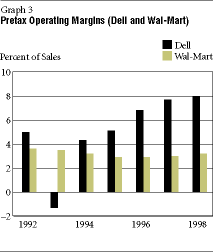 As remarkable as these operating performance results were,
an even bigger difference between Dell and Wal-Mart can be seen in inventory
management. Since Dell was always a direct retailer that built to order,
rather than built to inventory, we would expect that they turned over
their inventory much more frequently than Wal-Mart, even before the impact
of the Internet. And as we can see in the years 1993 through 1995 (Graph
4), Dell turned over its inventory about 10 times a year, whereas Wal-Mart,
which had to stock substantial inventory in its stores, turned over its
inventory five times a year.
As remarkable as these operating performance results were,
an even bigger difference between Dell and Wal-Mart can be seen in inventory
management. Since Dell was always a direct retailer that built to order,
rather than built to inventory, we would expect that they turned over
their inventory much more frequently than Wal-Mart, even before the impact
of the Internet. And as we can see in the years 1993 through 1995 (Graph
4), Dell turned over its inventory about 10 times a year, whereas Wal-Mart,
which had to stock substantial inventory in its stores, turned over its
inventory five times a year.
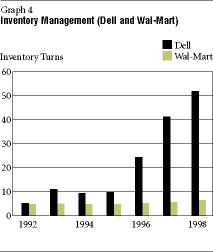 However, after 1995 Dell's inventory revolution hit, and
from 1995 to 1998 Dell mastered supply-chain management so well that it
achieved more than 50 inventory turns a year. As du Pont and Sloan showed
us years ago, inventory turns are particularly important for retail profitability
for two reasons: First, with low inventory, a firm doesn't face the costs
of tying up capital for inventory financing; second, if inventory is small,
it's much less likely that the products won't sell, so the risk of inventory
losses showing up in operating profits are greatly reduced.
However, after 1995 Dell's inventory revolution hit, and
from 1995 to 1998 Dell mastered supply-chain management so well that it
achieved more than 50 inventory turns a year. As du Pont and Sloan showed
us years ago, inventory turns are particularly important for retail profitability
for two reasons: First, with low inventory, a firm doesn't face the costs
of tying up capital for inventory financing; second, if inventory is small,
it's much less likely that the products won't sell, so the risk of inventory
losses showing up in operating profits are greatly reduced.
High-tech vs. high-tech
The comparison between Wal-Mart and Dell might suggest to the reader that there's only been a big difference between high-tech and more traditional low-tech firms in performance during the past few years. What's really new here, the reader might ask? What about the Internet? To get some sense for how much the Internet has affected productivity, let's compare Dell with one of its Texas neighbors, the computer manufacturer Compaq, which until recently, had very little Internet presence.
If we compare the pretax operating margins for Dell and Compaq from 1995 through 1997 (Graph 5), there would seem to be very little difference in the operating performance of the firms.
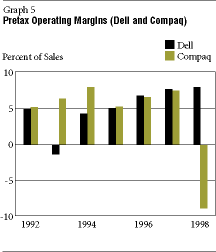 The data from those three years wouldn't give you any hint
about the meltdown that Compaq faced in 1998. So where did that difference
come from? Once again, let's take a look at inventory management for the
two firms. Since Dell was always a made-to-order computer firm, while
Compaq sold principally through stores, we would expect, even before 1996,
that Dell's inventory turns would have been much higher than Compaq's,
because Dell was building to ship directly to customers, while Compaq
was building for inventory that it would ship to stores. And indeed, if
we look at inventory turns for the two firms from the years 1993 to 1995,
Dell's inventory turns were roughly twice those of Compaq: 10 times a
year for Dell, and about five times a year for Compaq.
The data from those three years wouldn't give you any hint
about the meltdown that Compaq faced in 1998. So where did that difference
come from? Once again, let's take a look at inventory management for the
two firms. Since Dell was always a made-to-order computer firm, while
Compaq sold principally through stores, we would expect, even before 1996,
that Dell's inventory turns would have been much higher than Compaq's,
because Dell was building to ship directly to customers, while Compaq
was building for inventory that it would ship to stores. And indeed, if
we look at inventory turns for the two firms from the years 1993 to 1995,
Dell's inventory turns were roughly twice those of Compaq: 10 times a
year for Dell, and about five times a year for Compaq.
However, as described earlier, starting in 1996 something happened. Both firms dramatically improved their inventory management and in 1996 through 1998, Compaq's inventory turns were roughly what Dell's had been in 1993 through 1995. But Dell blew inventory management off the charts, and over that same period the ratio of Dell's inventory turns to Compaq's inventory turns was 5:1, up from only 2:1 in 1995.
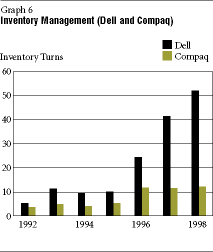 How did this happen? It was the increased control of its
inventories that helped Dell manage its costs so that it could undercut
Compaq's prices and grow so strongly, both in profitability and in market
share, at a time when Compaq suffered huge losses.
How did this happen? It was the increased control of its
inventories that helped Dell manage its costs so that it could undercut
Compaq's prices and grow so strongly, both in profitability and in market
share, at a time when Compaq suffered huge losses.
So is this just another story of inventory turns and technology? Where did Dell's great success—even against other high-tech firms—come from? Ironically, and once again akin to the turnaround experienced by an earlier General Motors, the roots of Dell's success were planted in its great failure of 1993. In 1993, Dell nearly lost its shirt in the notebook market, leading Michael Dell—the firm's founder—to sit down with his top management group and say, in effect: "There are two things we don't know. First, we don't know which products actually make us money; and second, we don't know how to motivate people so that they produce great operating performance and good inventory management."
Dell decided that the way to get better performance was to change the way that it paid employees, and starting in 1995 employees in the firm would receive a bonus based on economic profit, which is very different from accounting profit. Economic profit measures operating performance and asset management at the same time. Since it is expensive for all firms to tie up assets, a firm that produces $1 million in net operating profits after taxes with a capital base of only $1 million is certainly performing much better than a firm that produces $1 million in operating profits after taxes with a capital base of $10 million. Accounting income measures don't take capital charges into account, but economic profit does. Paying employees based on economic profit gets them to focus on efficient asset management as well as good operating performance.
Again, these ideas are not new, and again we look to Alfred P. Sloan, who paid his managers at General Motors based on these ideas back in the 1920s; this compensation system was one of the key elements in General Motors' rise and its eclipse of Ford as the world's largest automobile manufacturer. Today, Dell attributes a great portion of its recent success to its use of economic profit bonuses as a way to motivate every employee in the firm.
Merging good management with new technology
At this point, the reader might ask if economic profit only works, or works best, at a high-tech firm. What about low-tech firms? Can low-tech firms really get productivity out of using economic profit? Let's take a look at something really low-tech: office furniture. When Herman Miller, a furniture manufacturer in western Michigan, hired its new chief executive officer in 1995, the first thing he said to his chief financial officer was that he wanted to implement an economic profit-based compensation system. Herman Miller is the kind of firm that many other businesses would emulate. It had a strong commitment to its employees, wonderful relations with customers, a great environmental track record and world-class design. In fact, its design is so good that last year BusinessWeek awarded Miller's Aeron chair the award for being the best-designed product anywhere in the world in the last 10 years. But there was one group that, arguably, had been left out of Miller's commitment, and that was shareholders. Miller's stock price was almost the same in June 1995 as it had been in June 1990, even though the stock market was in a huge boom then.
Herman Miller adopted its economic profit program and rolled it out to all employees in the firm after 1995, so that everyone, including workers on the shop floor, would get bonuses for improved operating performance and asset management. We can see the productivity effects of the new compensation system by comparing Herman Miller's operating performance with that of HON Industries, a furniture maker in Muscatine, Iowa, that did not adopt any new compensation methods.
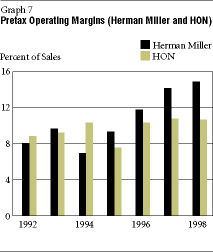 If we compare the pretax operating margins of Herman Miller
and HON from 1994 through 1998, we can see how much of a difference the
compensation system made. Between 1994 and 1998, HON's pretax operating
margin was nearly flat at around 10 percent. In 1994, Herman Miller wasn't
performing nearly as well as HON; its pretax operating margin was only
7 percent, but by 1998, its margin had doubled to more than 14 percent.
If we compare the pretax operating margins of Herman Miller
and HON from 1994 through 1998, we can see how much of a difference the
compensation system made. Between 1994 and 1998, HON's pretax operating
margin was nearly flat at around 10 percent. In 1994, Herman Miller wasn't
performing nearly as well as HON; its pretax operating margin was only
7 percent, but by 1998, its margin had doubled to more than 14 percent.
But as impressive as these gains in operating performance were, Miller's gains in inventory management were even greater.
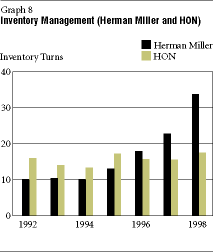 If we compare the two firms in the years 1993 through 1995,
we can see that in every year HON had better inventory management, as
measured by the number of inventory turns, than Herman Miller. But in
1996, Miller's performance started to improve dramatically. From 1995
through 1998, HON's inventory turns remained roughly constant at around
16, but Herman Miller's climbed from 12 all the way up to 35. These were
35 inventory turns a year for a furniture manufacturer whose principal
source of sales was not the Internet.
If we compare the two firms in the years 1993 through 1995,
we can see that in every year HON had better inventory management, as
measured by the number of inventory turns, than Herman Miller. But in
1996, Miller's performance started to improve dramatically. From 1995
through 1998, HON's inventory turns remained roughly constant at around
16, but Herman Miller's climbed from 12 all the way up to 35. These were
35 inventory turns a year for a furniture manufacturer whose principal
source of sales was not the Internet.
This incredible performance was possible only because the employees at Herman Miller all had the incentive to work for better inventory management. But does this mean that new technologies had no impact on Herman Miller's improved performance? No—new technology played a crucial role in combination with those incentives. Employees were eager to learn and highly motivated to implement the right kinds of new technology: enterprise resource planning, inventory management software and closer relations with suppliers and vendors. In the end, Herman Miller had set a new standard of inventory management.
New technology and comparative advantage
Both at Dell and at Herman Miller, the technology did not cause the productivity increases and the inventory turns by itself, nor did incentives; they worked in tandem. Motivated employees demanded the right technologies to improve operating performance and asset management. Now, even if we're convinced that incentives can be very important in greatly improving firm performance, why did this happen now, rather than 10 or 15 years ago? Here is where new technology can make a difference: It can influence how well a firm specializes.
Back in 1993 when Michael Dell asked his management team to help decide what products actually made them money and which ones didn't, Dell came to an important conclusion: The company should only specialize in the things that it did absolutely best—like product design, marketing and customer service—and it should leave much of the manufacturing to others. Dell decided that they had no more business making computer motherboards than Michael Jordan had mowing his own lawn, and this is where new technology comes into play—with the Internet, high-speed telecommunications, e-commerce software and business-to-business supply-chain management software, Dell was able to outsource its motherboard production with different firms around the world. This specialization-this application of the old economic principle of comparative advantage—helped Dell to turn the tide on profitability.
Even if firms had created the right incentives in the past, new technologies have allowed opportunities that weren't possible five years ago. In other words, incentives, coupled with new technology, have created renewed focus by firms and increased productivity through specialization on a firm's true comparative advantage.
What does this mean for the future?
Since so many firms have yet to adopt the best practices of the
best-performing firms in America, it seems safe to assume that the economy
still has a lot of headroom, a lot of capability, for productive growth.
Admittedly, the analysis described here is based on observations of only
a few firms; however, I am in the process of accumulating further data
and, thus far, this effort only reinforces the conclusion. The U.S. economy,
in effect, could be at the beginning of a long-term trend in productivity
growth and, hence, low-inflationary economic growth.
This, of course, almost sounds too good to be true, and hence there are pessimists who reflexively don't believe it. The U.S. unemployment rate is so low, these pessimists say, and labor seems so scarce, that the economy can't keep growing at its recent rapid rate without renewed inflation. But history suggests otherwise. For example, in the mid-1970s, when oil prices quadrupled, the U.S. economy went into a tailspin, but over the next decade the country doubled the fuel efficiency of its cars, blew insulation into its attics, retrofitted power plants and jet engines, and explored for new sources of energy. Within 10 years, the United States had adapted to high energy prices and OPEC lost its power. Last year, when the oil prices more than doubled, the increase had very little effect on our economy.
In another case, economists have been warning of impending labor shortages for more than a decade; baby boomers aren't entering the workforce any more, women's labor force participation has peaked out, and there haven't been that many new workers entering the labor force. Some view this development as cause for grave concern about future economic growth, but others have viewed it as an opportunity. If we were able to adapt to the unforeseen huge price increase in oil prices in the 1970s, imagine how we will be able to adapt to a foreseen change in labor supply. Indeed, many entrepreneurs recognized that a labor shortage was ahead and decided that they could make a fortune by developing technologies, like the Internet, e-commerce and wireless communication, that could conserve on labor. And they did. Labor shortages have encouraged new technologies and increased capital investment that have brought about high-productivity growth in the last few years. We're selling the flexibility of our economy short if we don't believe that entrepreneurs will take the opportunity to develop new technologies that save labor, and that we'll all benefit as a result.
In the 1870s, as national markets emerged, cities around the United States specialized in various markets—Pittsburgh in steel, Chicago in meat packing, Minneapolis in milling-and that specialization greatly enhanced productivity growth. Between 1870 and the outbreak of World War I, productivity growth boomed in the United States, and grew much faster than it had in the previous 100 years. This great productivity boom was brought about by specialization, by comparative advantage, and this lesson has been relearned throughout history, beginning, in part, with General Motors in World War I and continuing today with companies like Dell and Herman Miller.
If U.S. firms provide their workers with the incentives to learn and to adopt the right technologies, and these companies take advantage of specialization, the United States can experience a new era of global comparative advantage that will bring about productivity growth for many years to come. Globally speaking, that so few firms really understand these lessons and how to properly implement them, it means there's a vast potential for increased specialization and increased growth worldwide.
Runkle is currently on leave from the Fed to teach and do research on equity valuation in the Equity Research Department of U.S. Bancorp Piper Jaffrey Inc. and at the Carlson School of Management at the University of Minnesota.
David Runkle is a research officer in the Minneapolis Fed's research department. In addition, he is currently a consultant to U.S. Bancorp Piper Jaffray Inc. and an adjunct professor of finance in the Carlson School of Management at the University of Minnesota. Before joining the staff at the Minneapolis Fed in 1987, Runkle was an assistant professor of economics at Brown University.
He received his doctorate in economics from the Massachusetts Institute of Technology and his bachelor's degree from Carleton College.



